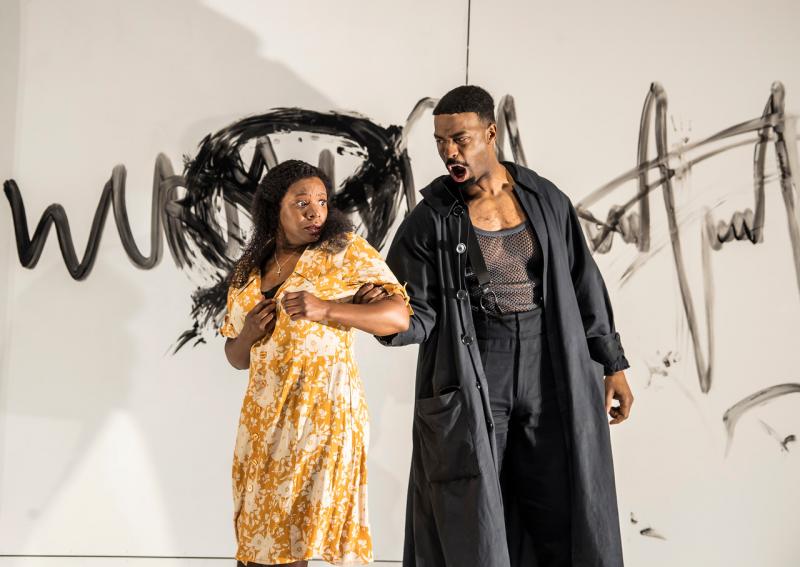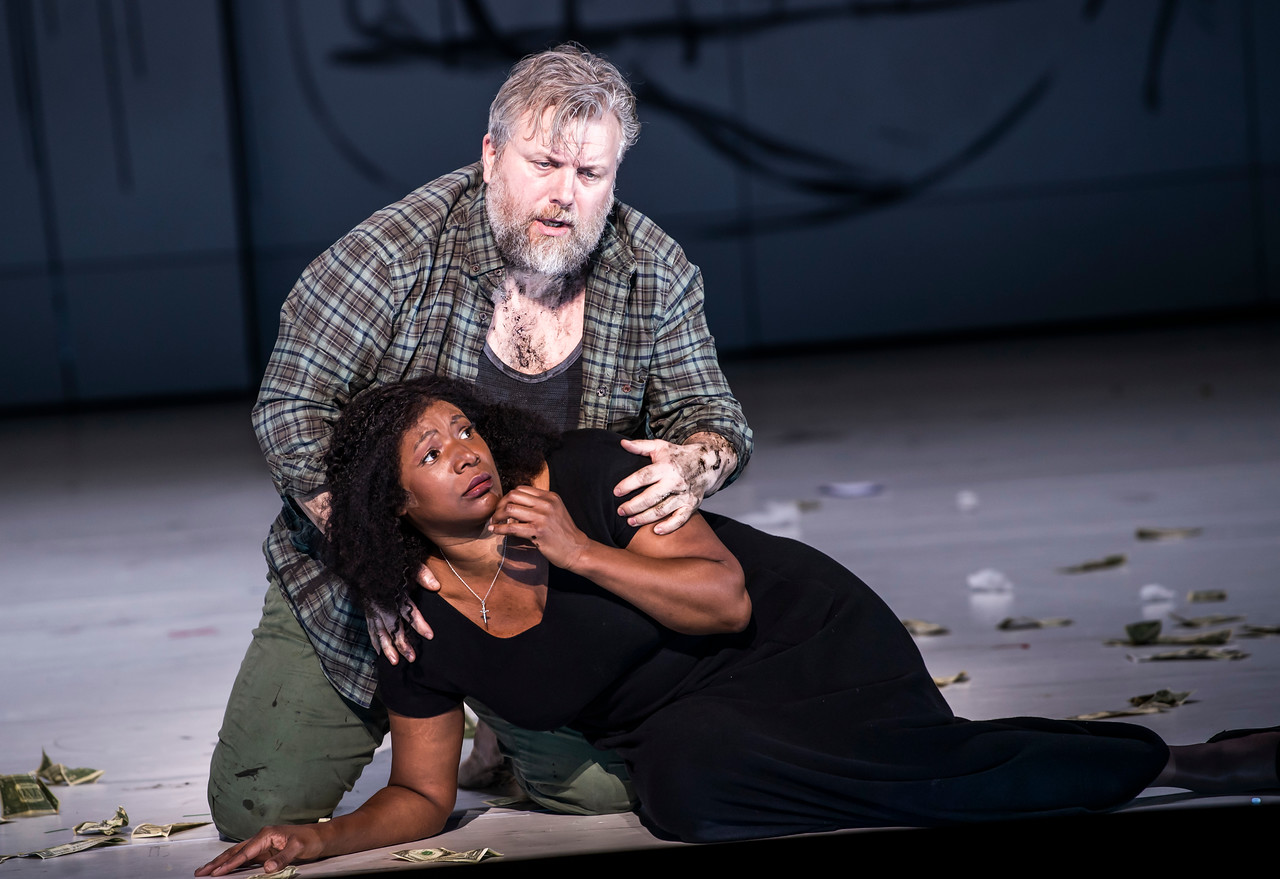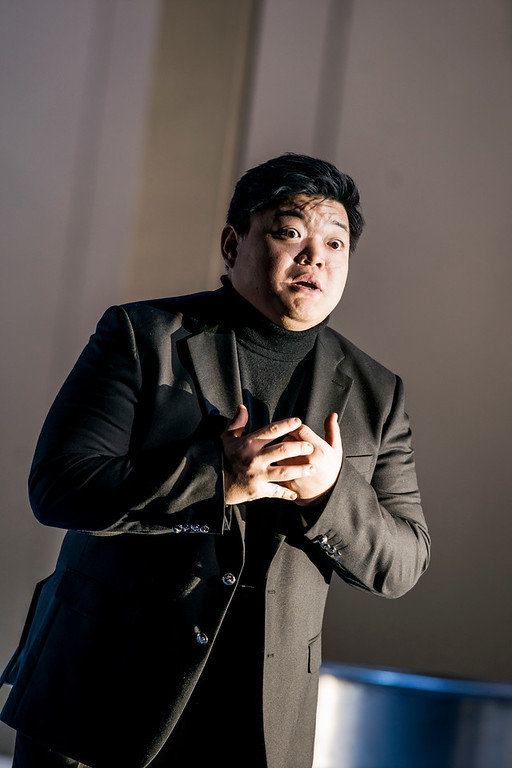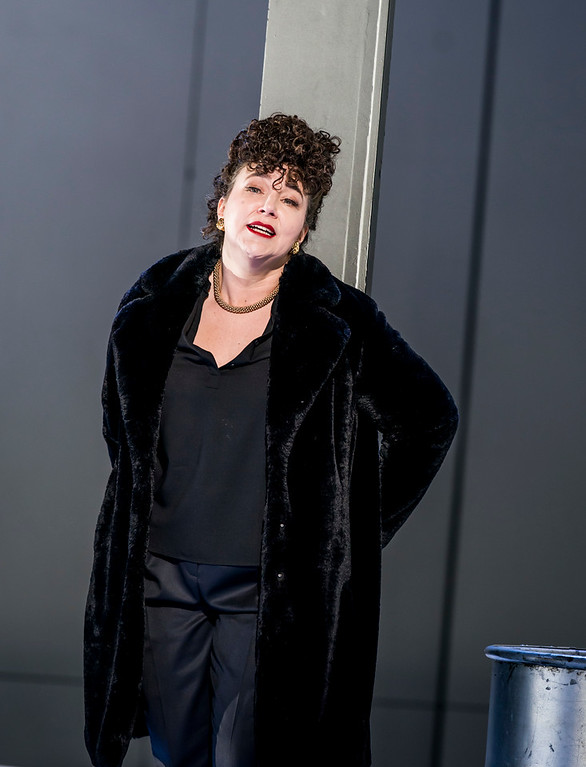Luisa Miller, English National Opera review - Verdi in translation makes a stylish comeback | reviews, news & interviews
Luisa Miller, English National Opera review - Verdi in translation makes a stylish comeback
Luisa Miller, English National Opera review - Verdi in translation makes a stylish comeback
Musical splendours peak in a tenor aria to die for and a moving last act

Those who booed the production team last night - there was nothing but generous cheering for singers, conductor and orchestra - might reflect that this was at least regietheater, that singular brand of not-all-bad director's opera in Germany, with discipline and purpose close enough to its subject.
Think back to Daniel Kramer's party nightmare in La traviata and you'd have to admit that this was strictly organised mess, however cheap-looking at first, which always let the singers be heard, never getting too much in the way of the crucial one-to-ones. Verdi's Luisa Miller may not be anything like its source, Schiller's Kabale und Liebe (Intrigue and Love), but there's just enough about class and sexism to connect with, and the score is often remarkable. It needs authentic Italian style from the conducting and three strong singers; here it got six.
You knew you were in safe Verdian hands from the way that Alexander Joel conducted the opening phrases of the Overture, symphonically developed in a way that shows the master Verdi of the middle years – Rigoletto and La traviata were just around the corner – and there was nothing jarring about Horáková’s introduction of two children who, it would soon be clarified, were younger versions of commoner Luisa and her nobleman-suitor Rodolfo, painting “amor” on wings of Andrew Lieberman‘s soon-to-be besmirched white, bright set (confusingly, though, this couldn’t have happened since in the opera, not in the play, Rodolfo woos in disguise – these lovers were never kids together. Take it as symbolic of the young spirits within).  The score’s move from pastoral to melodrama and finally to poetic pathos is embodied in its heroine: a vocal problem, since she must embrace the light and girlish at the start of the first act, the dramatic when faced with evil machinations in the second, and an other-worldly resolution in the third. Immensely sympathetic Elizabeth Llewellyn pulled off the early coloratura, just about held the lyric voice together when going for the big guns in the Act Two aria and came fully into her own for the masterly final duets.
The score’s move from pastoral to melodrama and finally to poetic pathos is embodied in its heroine: a vocal problem, since she must embrace the light and girlish at the start of the first act, the dramatic when faced with evil machinations in the second, and an other-worldly resolution in the third. Immensely sympathetic Elizabeth Llewellyn pulled off the early coloratura, just about held the lyric voice together when going for the big guns in the Act Two aria and came fully into her own for the masterly final duets.
The one with father Miller, newly released from the dastardly Count’s prison because of his daughter’s sacrifice, not only shows Verdi as the master of original orchestral colours; it also embraces a crucial change of heart, as Luisa gives up her idea of suicide to honour her poor old dad. Llewellyn and Icelandic baritone Olafur Sigurdarson – stalwart, plausible, though sounding a bit as if he might have forced the singing, unnecessary in the Coli - made this moving to tears at the calmest moment, when Luisa tells her father to get some rest before they go off a-roving in the morning (Sigurdarson and Llewellyn pictured above).
 Then comes the crunch: the girl poisoned by her lover when he still believes her unfaithful. The top purely vocal thrill of the evening came from former Royal Opera Jette Parker Young Artist David Junghoon Kim (pictured left), the bright Verdi tenor to the life, nuanced, subtle in piano, searingly intense at full pelt, making an absolute dream of the opera’s best-known aria, best known in the Italian as “Quando le sere al placido”. Kim may not be the greatest actor – few Italianate tenors of this sort are – but he was game enough to wrestle with the movement group, representing the malign forces of Wurm’s machinations, in his cabaletta.
Then comes the crunch: the girl poisoned by her lover when he still believes her unfaithful. The top purely vocal thrill of the evening came from former Royal Opera Jette Parker Young Artist David Junghoon Kim (pictured left), the bright Verdi tenor to the life, nuanced, subtle in piano, searingly intense at full pelt, making an absolute dream of the opera’s best-known aria, best known in the Italian as “Quando le sere al placido”. Kim may not be the greatest actor – few Italianate tenors of this sort are – but he was game enough to wrestle with the movement group, representing the malign forces of Wurm’s machinations, in his cabaletta.
In the original cast list, father, daughter and lover are the “primi”, the leads, while three more characters appear as “comprimarii”, supporting roles. There was nothing secondary about any of the singers in question. Dependable James Creswell as Rodolfo’s criminal father, Count Walter, stayed firm in the face of some of Horáková’s more, shall we say, challenging ideas (was the boy in underpants an adolescent Rodolfo? I left my programme in the theatre, so I never got to read the director’s notes, but one shouldn’t have to).
 Soloman Howard’s Wurm offered bass-hunk appeal, a big presence both physically and vocally, while the biggest luxury of all was to have great British mezzo Christine Rice as Luisa’s love-rival, the Duchess Federica of Oatheim (pictured right). She had been down to sing Eboli in Don Carlo at the Royal Opera, but had to pull out due to illness; this very limited role gave intimations of what we might get there – ENO could even pull it off with this current dream team.
Soloman Howard’s Wurm offered bass-hunk appeal, a big presence both physically and vocally, while the biggest luxury of all was to have great British mezzo Christine Rice as Luisa’s love-rival, the Duchess Federica of Oatheim (pictured right). She had been down to sing Eboli in Don Carlo at the Royal Opera, but had to pull out due to illness; this very limited role gave intimations of what we might get there – ENO could even pull it off with this current dream team.
With another sympathetic girl to back up Luisa in the form of Nadine Benjamin’s friend Laura, the opening choral scenes transcended borderline silliness in the Day-of-the-Dead costuming (better marshalled, at least, than in Kramer’s Birwistle Mask of Orpheus). The splendid chorus, inevitably dogged by a hint of G&S in the painfully old-fashioned English translation, provided a big thrill in the Act One ensemble; with Llewellyn crowning the line, it was a bit like the ENO Powerhouse days when Davids Alden and Fielding challenged us with their abstractions and a vocal team impressed. Hopefully there’ll be more from this excellent line-up; Verdi has come back to the Coliseum trailing clouds of glory.
rating
Explore topics
Share this article
Add comment
The future of Arts Journalism
You can stop theartsdesk.com closing!
We urgently need financing to survive. Our fundraising drive has thus far raised £49,000 but we need to reach £100,000 or we will be forced to close. Please contribute here: https://gofund.me/c3f6033d
And if you can forward this information to anyone who might assist, we’d be grateful.

Subscribe to theartsdesk.com
Thank you for continuing to read our work on theartsdesk.com. For unlimited access to every article in its entirety, including our archive of more than 15,000 pieces, we're asking for £5 per month or £40 per year. We feel it's a very good deal, and hope you do too.
To take a subscription now simply click here.
And if you're looking for that extra gift for a friend or family member, why not treat them to a theartsdesk.com gift subscription?
more Opera
 La bohème, Opera North review - still young at 32
Love and separation, ecstasy and heartbreak, in masterfully updated Puccini
La bohème, Opera North review - still young at 32
Love and separation, ecstasy and heartbreak, in masterfully updated Puccini
 Albert Herring, English National Opera review - a great comedy with depths fully realised
Britten’s delight was never made for the Coliseum, but it works on its first outing there
Albert Herring, English National Opera review - a great comedy with depths fully realised
Britten’s delight was never made for the Coliseum, but it works on its first outing there
 Carmen, English National Opera review - not quite dangerous
Hopes for Niamh O’Sullivan only partly fulfilled, though much good singing throughout
Carmen, English National Opera review - not quite dangerous
Hopes for Niamh O’Sullivan only partly fulfilled, though much good singing throughout
 Giustino, Linbury Theatre review - a stylish account of a slight opera
Gods, mortals and monsters do battle in Handel's charming drama
Giustino, Linbury Theatre review - a stylish account of a slight opera
Gods, mortals and monsters do battle in Handel's charming drama
 Susanna, Opera North review - hybrid staging of a Handel oratorio
Dance and signing complement outstanding singing in a story of virtue rewarded
Susanna, Opera North review - hybrid staging of a Handel oratorio
Dance and signing complement outstanding singing in a story of virtue rewarded
 Ariodante, Opéra Garnier, Paris review - a blast of Baroque beauty
A near-perfect night at the opera
Ariodante, Opéra Garnier, Paris review - a blast of Baroque beauty
A near-perfect night at the opera
 Cinderella/La Cenerentola, English National Opera review - the truth behind the tinsel
Appealing performances cut through hyperactive stagecraft
Cinderella/La Cenerentola, English National Opera review - the truth behind the tinsel
Appealing performances cut through hyperactive stagecraft
 Tosca, Royal Opera review - Ailyn Pérez steps in as the most vivid of divas
Jakub Hrůša’s multicoloured Puccini last night found a soprano to match
Tosca, Royal Opera review - Ailyn Pérez steps in as the most vivid of divas
Jakub Hrůša’s multicoloured Puccini last night found a soprano to match
 Tosca, Welsh National Opera review - a great company reduced to brilliance
The old warhorse made special by the basics
Tosca, Welsh National Opera review - a great company reduced to brilliance
The old warhorse made special by the basics
 BBC Proms: The Marriage of Figaro, Glyndebourne Festival review - merriment and menace
Strong Proms transfer for a robust and affecting show
BBC Proms: The Marriage of Figaro, Glyndebourne Festival review - merriment and menace
Strong Proms transfer for a robust and affecting show
 BBC Proms: Suor Angelica, LSO, Pappano review - earthly passion, heavenly grief
A Sister to remember blesses Puccini's convent tragedy
BBC Proms: Suor Angelica, LSO, Pappano review - earthly passion, heavenly grief
A Sister to remember blesses Puccini's convent tragedy
 Orpheus and Eurydice, Opera Queensland/SCO, Edinburgh International Festival 2025 review - dazzling, but distracting
Eye-popping acrobatics don’t always assist in Gluck’s quest for operatic truth
Orpheus and Eurydice, Opera Queensland/SCO, Edinburgh International Festival 2025 review - dazzling, but distracting
Eye-popping acrobatics don’t always assist in Gluck’s quest for operatic truth

Comments
This sympathetic review
No, I agree; I already knew
No, I agree; I already knew that the opera itself gets progressively better, that as you say the music of the first act is the weakest (though always interesting), that Verdi starts finding his feet in Act Two and that Act Three is as fine as the best of Rigoletto, Trovatore and Traviata. I wouldn't have expected to be moved until then, but I'm so glad that these singers won that emotional response - much more so than at a Royal Opera revival about which I can remember little.
The back-history about the murdered cousin is so sketchy that it can't really be brought to life in a production idea. And that was one which definitely didn't work - nasty without being significant.
A wonderful evening
Great evening. Good to see
I agree with Peter Lawley's